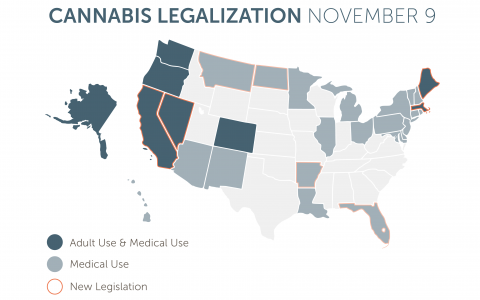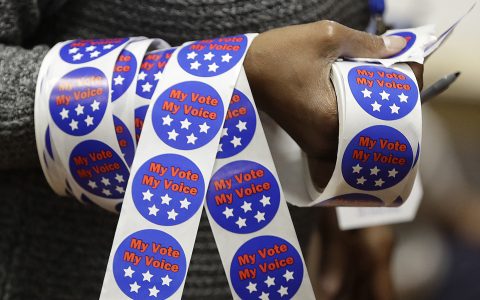The returns from last week’s election didn’t just represent a triumph for cannabis legalization advocates. Data from the Nov. 8 vote also revealed a political paradigm shift. This is the year that the issue of legalization broke free from traditional conservative–liberal boundaries.
Over the course of about ten hours on election night, a surprising trend caught the attention of editors here at Leafly: Voters in extremely conservative counties were approving cannabis legalization measures—in some cases by wide margins.
It didn’t happen everywhere. But in a large number of deeply red districts the vote wasn’t even close. They were going for legalization to the tune of 55 percent, 60 percent, 65 percent.
Exhibit A: Union County, Florida. Smallest county in the state. Landlocked, off the beaten path between Jacksonville and Gainesville. Population: 15,535. Union County’s largest employer is a state prison. Donald Trump captured 80 percent of the vote there. Hillary Clinton, 18 percent. And do you know how they voted on Amendment 2, Florida’s statewide measure to legalize medical cannabis? 65 percent yes.
A similar story played out in the conservative Florabama counties in the state’s northern panhandle:
- Okaloosa County is one of the most conservative counties in Florida. It swung 70 percent for Trump, 72 percent for medical cannabis. Amendment 2 came within 40 ballots of equaling Trump’s Okaloosa County vote total of 71,788.
- Suwannee County displays its Bible Belt heritage on the county elections supervisor’s website, which is wrapped in an “In GOD We Trust” banner. Until five years ago, Suwannee County was defiantly dry, forbidding the sale of alcohol. Trump: 76 percent. Medical cannabis legalization: 62 percent.
Did the same thing happen in other states? It did.
Here at the Leafly elections desk, no state popped our eyes wider than North Dakota. Going into Election Day we had zero polling data on North Dakota’s Measure 5, medical cannabis legalization. That did not bode well. North Dakota = farmers, football players, oil frackers, and Fargo. And apparently zero political pollsters. My colleagues and I figured it might pull 39 percent to 42 percent of the vote. And that would have been OK. It’s not unusual for marijuana legalization measures to endure one or two failed tries before finally passing.
Forget about it. Measure 5 crushed it, 64 percent to 36 percent.
We started throwing darts at the North Dakota map. Five counties at random. Here’s what we found:
- McHenry County: Trump 73 percent, medical cannabis 58 percent.
- Dunn County: Trump 79 percent, medical cannabis 54 percent.
- Barnes County: Trump 59 percent, medical cannabis 59 percent.
- Stutsman County: Trump 68 percent, medical cannabis 64 percent.
- Eddy County: Trump 65 percent, medical cannabis 60 percent
That’s medical. What about adult use?
Adult-use measures are tougher to pass. When you vote for medical legalization, you’re showing mercy to epileptic kids. When you vote to legalize and regulate adult use, you’re overturning the war on drugs and eight decades of government-funded anti-cannabis doctrine.
Five states considered adult-use measures earlier this week: California, Nevada, Arizona, Massachusetts, and Maine. All but Arizona passed.
The approval numbers weren’t as high as for medical marijuana, but the same pattern held.
Consider Maine. Up in the north woods, Mainers legalized the regulated sale and use of cannabis by an extremely tight margin. The Associated Press had to wait two days before finally calling the vote for legalization, 50.2 percent yes to 49.8 percent no. (Opponents of Question 1, the adult-use legalization measure, are now petitioning for a recount.)
The stronger a Massachusetts county pulled for Hillary, the weaker its support for adult-use legalization.
Franklin County, Maine, is the second least-populated county in the state. The Stanley twins, inventors of the Stanley Steamer automobile, were born here in the 1800s. Since then it’s been nothing but syrup and crickets. Trump captured 48 percent of the 16,382 vote cast in Franklin County. Clinton got 43 percent. Question 1 actually lost here—but just barely. No votes outnumbered yes votes in Franklin County, 50.4 percent to 49.6 percent.
Trump did better in Oxford County, directly south of Franklin. There he captured 52 percent of the vote to Clinton’s 39 percent. Question 1 carried 50.8 percent of the vote. In other words, Oxford swung more conservative than Franklin county and yet adult-use legalization performed better there.
Things were even more interesting in Massachusetts.
In presidential elections, Massachusetts votes as blue as the King’s suede shoes. But when you dive into last Tuesday’s data, here’s what you find: The stronger a Massachusetts county pulled for Hillary, the weaker its support for adult-use legalization.
Look at Suffolk County, which encompasses Boston. Voters there went wild for Clinton, casting 79.5 percent of their ballots for the Democratic nominee. But just 62 percent voted for legalization—a difference of 17.5 percent.
- Berkshire County, where Massachusetts corners into Vermont and New York, also went big for Clinton (67.5 percent) but not so big for legalization (58 percent).
- Norfolk County, same thing: 61.2 percent for Clinton, 51 percent for legalization.
It’s not a hard-and-fast rule, but in general the Massachusetts counties that gave Clinton her biggest majorities showed the widest disparity between Democratic Party votes and legalization votes.
- In Worcester County, Clinton squeaked by with 51.7 percent of the vote. Legalization actually outpolled her there, at 53 percent.
- Plymouth County: 50.7 percent for Clinton, 50.3 percent for legalization.
Weren’t the numbers similar in 2012?
Not at all. In 2012, the legalization votes in Colorado and Washington state lined up mainly along partisan lines. Most Obama supporters voted for legalization. Most Romney voters opposed it. There were a few outlier counties that hinted at the possibility of a crossover, but nothing like what we saw this year.
In Washington, counties that voted heavily for Republican nominee Mitt Romney generally opposed Initiative 502, the adult-use measure, and vice versa. Like this:
- Garfield County, which pulled 71 percent for Romney, also opposed legalization by 62 percent.
- Benton County went 62 percent for Romney 56 percent opposed legalization.
- 69 percent of King County, which encompasses liberal Seattle, swung for Obama, while 63 percent voted for legalization.
Between 2012 and 2016, many conservative voters changed their minds and became legalization supporters.
In those numbers you can catch a glimpse of things to come. Not all Romney supporters voted against legalization, and not all Obama supporters voted for it. There were a couple counties that voted for Romney and legalization, but just barely. (They were Okanogan and Chelan counties, interestingly, which now host some of the state’s most successful outdoor cannabis growers.)
In Colorado a similar pattern held. Counties that voted for Mitt Romney also voted (although in slightly less strength) against Amendment 64, adult-use legalization:
- Baca County: 74 percent for Romney, 64 percent against legalization.
- Cheyenne County: 82 percent for Romney, 54 percent against legalization.
- In liberal Boulder County, by contrast, Obama pulled 70 percent of the vote and legalization tallied 63 percent.
So not every Obama voter supported legalization, not every Romney voter opposed it.
What’s going on here?
A couple things. First, don’t kid yourself. In general, liberal voters tend to support Democrats and cannabis legalization. But not all traditional liberals support legalization, and not all conservatives oppose it. In fact, the data indicate that between 2012 and 2016 many more conservative voters changed their minds and became legalization supporters.
One of the best voter surveys taken during the run-up to the November election, the Survey USA poll of California voters, offered some insight. (Leafly news editor Ben Adlin used the survey last month for an in-depth look at how various California voters were reacting to Prop. 64.)
In that survey, Democrats were more likely to support legalization than Republicans. But the numbers get interesting when you look at the degree of party affiliation.
When asked about their support for Prop. 64, “Strong Republicans” (44 percent) and “Independent Leaning Republicans” (40 percent) were far more likely to support legalization than voters who identified simply as “Republican” (28 percent).
Similarly, “Strong Democrats” (70 percent) and “Independent Leaning Democrats” (75 percent) were more likely to support legalization than plain-vanilla “Democrats” (57 percent).
Why the softness in the middle? It may have something to do with trust and change. Moderate party members tend to have centrist proclivities, which may grow out of a basic trust in the institutions of government. Many of those institutions—the federal Drug Enforcement Administration, the National Institutes of Health, the White House Office on Drug Control Policy, state and local law enforcement agencies—are among the last holdouts fighting to keep cannabis illegal.
The outlying wings of both parties tend to be more skeptical of the official line and more open to change. Some right-wing Republicans are embracing legalization because it represents an unwarranted intrusion of government in their lives. Voters who identify as “independent-leaning” Republicans or Democrats tend to not swallow the party line, but like to figure out each issue on its own merits. And if those folks are looking at cannabis, they’re likely to find science, experience, and common sense bending their vote toward legalization.
Any other factors?
It’s hard to overstate the importance of the Colorado–Washington experience. Both states have been legal now for four years, and none of the great fears of the prohibitionists have come to pass. In fact, both states are booming economically and have become magnets to a generation of migrating millennials seeking freedom, tolerance, and opportunity.
The most telling vote, in fact, may have been the one that almost everyone outside of Colorado ignored. On Tuesday, anti-cannabis prohibitionists tried to pass two identical measures in Pueblo, Colo.—one in the city of Pueblo, another in the surrounding Pueblo County—that would have banned cannabis farming and retail sales. Measure 300 gave Pueblo voters a chance to effectively re-do the election of 2012. Given their experience with adult use legalization, would they change their vote if they could go back in time to Nov. 2012?
Some voters did. But not in the way that Measure 300 supporters expected.
In 2012, 55 percent of Pueblo County voters (city and county) cast their ballots in favor of legalization. Four years later, 59 percent of those same voters decided to keep legalization. In other words, thousands of Pueblo citizens who voted against legalization in 2012 experienced regulated cannabis firsthand, liked what they saw, and changed their minds. Last Tuesday they voted to keep it.



